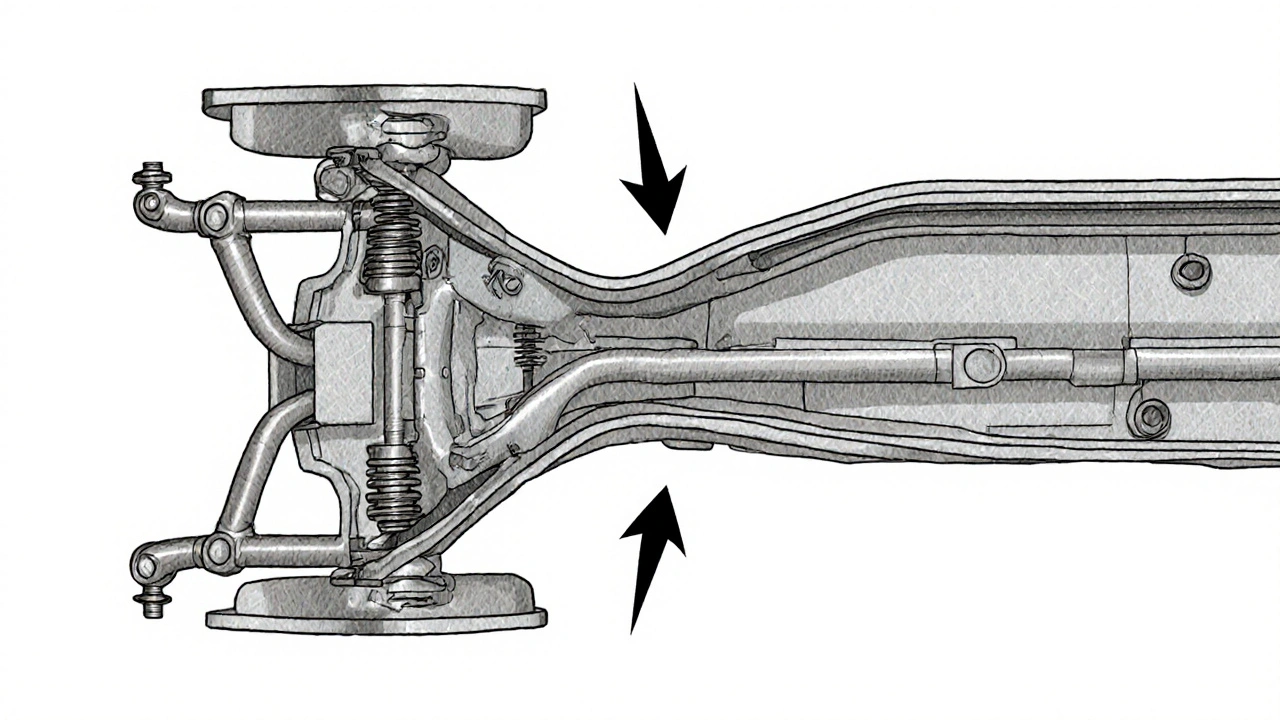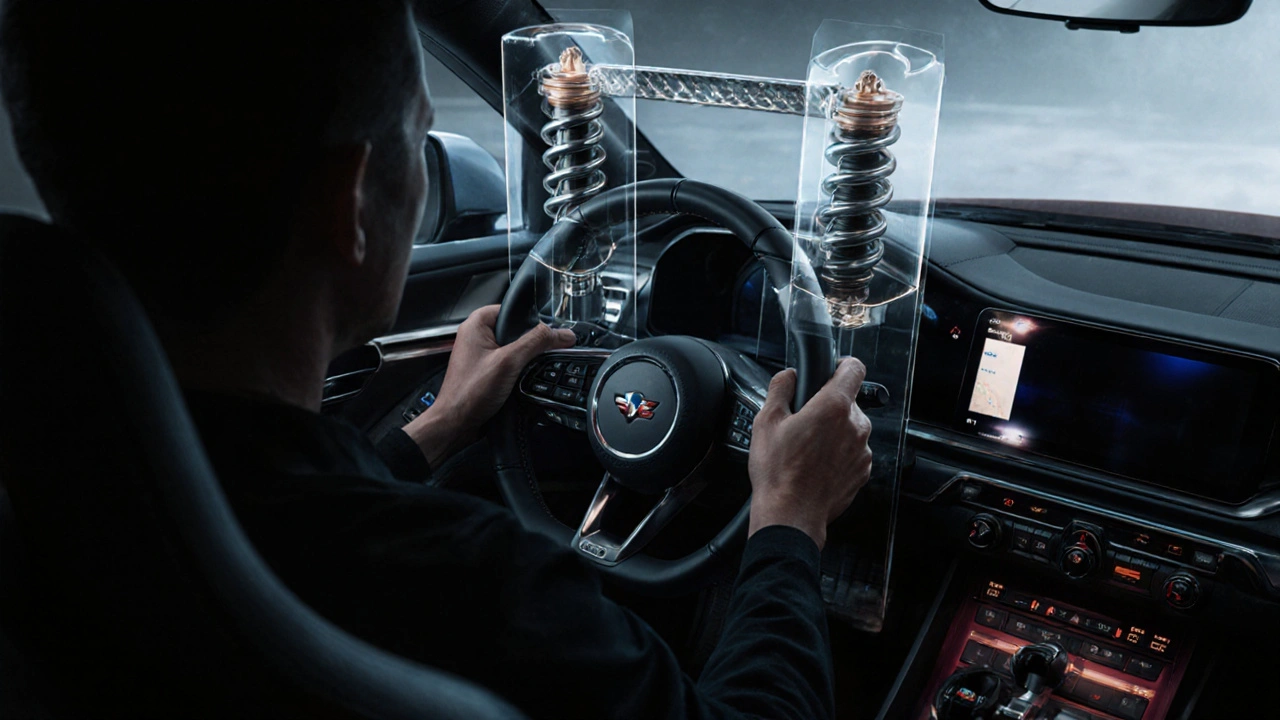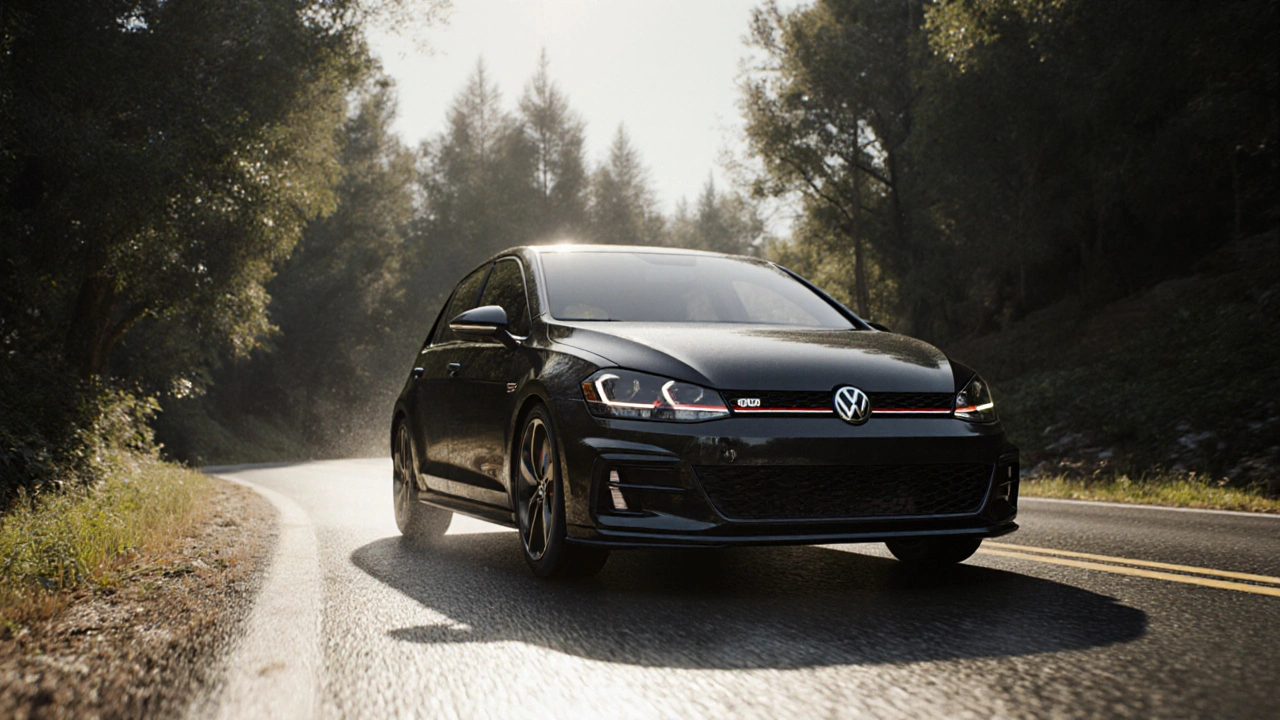Ever feel like your car leans too much in corners? Like the whole thing is tipping over when you take a fast exit on a back road? That’s body roll - and it’s not just annoying, it’s dangerous. It kills grip, makes steering feel vague, and turns a fun drive into a nervous one. The fix isn’t always new tires or a full suspension overhaul. Sometimes, it’s just two simple upgrades: strut braces and sway bars.
What Exactly Is Body Roll?
Body roll happens when your car’s weight shifts during cornering. As you turn, centrifugal force pushes the car outward. The suspension on the outside of the turn compresses, while the inside lifts. That tilting motion - the lean - is body roll. It’s normal to a degree. Even a brand-new Honda Civic rolls a bit. But in performance cars, modified cars, or cars with worn suspension, it gets worse.
Here’s why it matters: when your car rolls, the tires lose contact with the road. The outside tires bear most of the load, while the inside ones lift slightly. That reduces overall grip. Your steering feels slow to respond. The car doesn’t track where you point it. And if you’re pushing hard, you might even get a sudden loss of traction.
Think of it like standing on a skateboard and leaning to one side. The board tilts, and you lose balance. Your car does the same thing - except at 60 mph.
Chassis Rigidity: The Foundation of Good Handling
Your car’s chassis is its skeleton. In modern cars, it’s made of stamped steel, welded together. But even the stiffest factory chassis flexes under stress - especially when you hit bumps mid-corner or slam the throttle out of a turn. That flex is invisible, but it’s there. And it’s bad for handling.
When the chassis twists, your suspension geometry changes. The alignment shifts slightly. The wheels don’t stay planted where they should be. That’s why a car can feel loose or unpredictable, even with perfect tires and shocks.
Chassis rigidity isn’t about being heavy. It’s about being stiff. A rigid chassis keeps everything aligned, so your suspension can do its job properly. That’s where strut braces and sway bars come in.
Strut Braces: Stiffening the Top of the Suspension
A strut brace is a metal bar that connects the top mounts of your front (or rear) struts. It’s usually bolted under the hood, just behind the engine. It looks like a simple steel tube or bar, sometimes with a carbon fiber finish.
What it does: stops the firewall and strut towers from flexing inward during hard cornering. Without a brace, the strut towers can bend slightly - just enough to change camber and toe angles. That’s why your steering feels vague at the limit. With a brace, the towers stay put. The suspension stays aligned. You get sharper turn-in and better feedback.
Real-world effect? In a Ford Focus ST or a Subaru WRX, a front strut brace makes the car feel more planted. You can feel the difference in the steering wheel - less wobble, more precision. It’s subtle, but once you drive with one, you notice how sloppy the car felt without it.
Not all strut braces are created equal. Cheap ones are just thin tubes with flimsy mounts. Good ones are made from 20mm steel, with reinforced mounting points. Brands like Cusco, Whiteline, and ST Suspension make reliable ones. For most street cars, a front brace is enough. Rear braces exist, but they’re mostly for track cars or those with rear strut setups.
Sway Bars: Controlling Weight Transfer
A sway bar - also called an anti-roll bar - is a thick steel bar that connects the left and right wheels through links and bushings. It’s usually under the car, running across the axle.
Here’s how it works: when the car rolls, one side compresses and the other extends. The sway bar twists in response. That twisting force pushes back against the roll, keeping the car flatter. It doesn’t stop body roll completely - that’s not the goal - but it controls how much happens.
Factory sway bars are soft. They’re tuned for comfort, not grip. Upgrading to a thicker bar (say, from 20mm to 24mm) makes a huge difference. You’ll notice less lean in corners, faster response, and more even tire contact.
But there’s a catch: too stiff a bar can hurt ride quality. On rough roads, a too-stiff rear sway bar can make the car skip over bumps instead of absorbing them. That’s why adjustable sway bars are popular. You can dial in the stiffness based on whether you’re driving to work or heading to the track.
For a daily driver with occasional spirited driving, a 22mm front and 18mm rear bar combo (like from Eibach or Progress) strikes the right balance. For track use, go thicker - 25mm front, 20mm rear. Just remember: if you stiffen the front more than the rear, you’ll get understeer. Stiffen the rear more, and you’ll get oversteer. That’s tuning.

Strut Braces vs. Sway Bars: What’s the Difference?
People mix them up. They both reduce body roll. But they work in completely different ways.
Strut braces reduce chassis flex. They keep the suspension mounting points rigid. Think of them as adding structural support to the car’s frame.
Sway bars control weight transfer. They physically link the wheels and push back against the roll force. Think of them as a mechanical lever that fights the car’s natural tendency to lean.
You can have one without the other. But together? They’re a game-changer.
Let’s say you install only a sway bar. Your car will corner flatter, but the steering might still feel vague because the strut towers are still flexing. Install only a strut brace? The steering gets sharper, but the car still leans - just with more precision.
Put both on? The car feels like it’s bolted to the road. Turn-in is immediate. Mid-corner corrections are effortless. You stop guessing how much grip you have.
What’s the Real-World Impact?
Take a 2018 Volkswagen Golf GTI. Stock, it’s a fun hatchback. Add a Whiteline front strut brace and a 24mm rear sway bar. Now, it’s a different car.
On a twisty B-road near Bath, the difference is obvious. The car doesn’t lean. The front end bites instantly. You can carry more speed through corners without feeling like you’re about to slide. The steering feedback is clearer - you feel every bump, every change in grip. It’s not just faster. It’s more confidence-inspiring.
Another example: a 2020 Honda Civic Si. Factory sway bar is 20mm front, 18mm rear. Swap to a 22mm front and 20mm rear bar, and add a strut brace. The car stops feeling like it’s floating. It feels connected. You can drive it harder, with less thought.
These upgrades don’t add horsepower. They don’t make your car louder. But they make you feel like you’re driving a more serious machine.
Who Needs These Upgrades?
You don’t need them if you’re just commuting or driving in the rain. But if you enjoy driving - if you like taking corners with purpose - then yes.
Strut braces are ideal for:
- Front-wheel-drive hot hatches (Golf GTI, Civic Si, Focus ST)
- Japanese sports sedans (Honda Accord Type R, Subaru WRX)
- Any car with a front strut setup and noticeable steering vagueness
Sway bars are ideal for:
- Cars that feel too floaty in corners
- Drivers who want better tire contact and grip
- Anyone upgrading their suspension with lowering springs or coilovers
And if you’ve done any of these: upgraded shocks, added performance tires, lowered the car - then you’re already halfway there. Strut braces and sway bars are the final 20% that turn good handling into great handling.

Installation and Cost
Strut braces: Easy DIY. Most take under an hour. You need basic tools - socket set, torque wrench. Cost: £80-£200 depending on brand and material.
Sway bars: Slightly harder. You need to lift the car, remove stock bars, install new ones with new bushings. Takes 2-3 hours. Cost: £150-£400 for a quality set.
Both are bolt-on upgrades. No cutting, no welding. No permanent changes. You can remove them if you sell the car.
Pro tip: Always replace the bushings when installing a sway bar. Factory rubber bushings wear out and let the bar move slightly. Polyurethane or spherical bushings (like from Energy Suspension) give you zero deflection.
What Not to Do
Don’t install a huge sway bar on a car with stock suspension. It’ll make the ride harsh and unpredictable. Don’t install a strut brace without checking if your car has the right mounting points. Some cars (like older BMWs) need custom brackets.
Don’t expect miracles. These aren’t magic. They won’t turn a FWD economy car into a rear-wheel-drive sports car. But they will make your car feel more connected, more precise, and more fun.
Final Thought: It’s About Control
Driving isn’t just about speed. It’s about control. Strut braces and sway bars don’t make your car faster on paper. But they make you feel faster - because you’re more in control. You trust the car. You can push harder. You enjoy the drive more.
On a rainy Tuesday in Bristol, driving a modified Golf through the Mendips, that feeling matters more than any horsepower number.
Do strut braces and sway bars improve ride comfort?
No, they don’t. In fact, they usually make the ride firmer. Strut braces reduce flex, which can transmit more road noise and vibration. Sway bars reduce body roll, which can make the car feel stiffer over bumps. If comfort is your top priority, stick with stock. These upgrades are for drivers who want better handling, not a smoother ride.
Can I install a sway bar without upgrading shocks?
Yes, you can. But if your shocks are worn out, the benefits will be limited. Worn shocks can’t control the movement the sway bar is trying to manage. You’ll feel the improvement in cornering, but the car may still bounce or feel unstable over bumps. For best results, pair sway bar upgrades with good-quality shocks or coilovers.
Are strut braces worth it on rear-wheel-drive cars?
They’re less critical than on front-wheel-drive cars, but still helpful. In RWD cars like the BMW 3 Series or Nissan 370Z, front strut braces improve turn-in sharpness and reduce steering vagueness. Rear strut braces are rare and mostly used in track builds. For most street RWD cars, a front brace is enough.
Will these upgrades void my warranty?
Generally, no. Strut braces and sway bars are bolt-on parts that don’t modify the engine, transmission, or ECU. Under the Magnuson-Moss Warranty Act (in the US) and similar consumer laws in the UK, manufacturers can’t void your entire warranty just because you added aftermarket parts - unless they can prove the part caused the specific failure. Still, check your warranty terms if you’re unsure.
How do I know if my car needs a sway bar upgrade?
If your car leans noticeably in corners, or if you feel like the tires lose grip before you expect them to, your sway bar is likely too soft. If you’ve upgraded tires or lowered the car, that increases roll stiffness - and your factory sway bar may not keep up. A simple test: drive a familiar corner at moderate speed. If the car feels like it’s tipping over, a thicker sway bar will help.


Comments
Patrick Tiernan
Bro just put on some tires and stop overthinking this like its some sacred ritual
November 4, 2025 at 02:29
Patrick Bass
Strut braces do improve steering feel, but only if the chassis is actually flexible enough to warrant one. Many modern cars have sufficiently rigid structures already.
November 4, 2025 at 07:10
Tyler Springall
Let me be the first to say this: if you're still driving a Golf GTI and thinking about sway bars, you're not a driver-you're a spectator with a subscription to Car and Driver. Real enthusiasts build track cars, not 'spirited daily drivers.' This post reads like a brochure written by someone who thinks 'Bath' is a race circuit.
November 5, 2025 at 12:37
Colby Havard
It is, indeed, a matter of considerable scientific and engineering significance that chassis rigidity and weight-transfer dynamics are often misunderstood by the general motoring public. The integration of structural reinforcement components-namely, strut braces and sway bars-does, in fact, demonstrably alter the mechanical behavior of a vehicle’s suspension geometry under lateral load, thereby enhancing dynamic stability. One must not, however, conflate improved handling with increased safety; the latter requires holistic systems engineering, not merely bolt-on modifications.
November 6, 2025 at 02:32
Amy P
OMG YES. I put a Whiteline front brace and 24mm rear bar on my Civic Si last month and I swear I cried the first time I took the backroads near Asheville. It’s like the car finally listened to me. I didn’t know I was driving a boat until it became a scalpel. Also, the steering wheel doesn’t feel like it’s made of marshmallows anymore. I’m never going back. Also, my cat now sits in the passenger seat like she’s proud of me. This is life-changing.
November 7, 2025 at 04:32
Ashley Kuehnel
Hey everyone! Just wanted to add a quick tip-if you’re installing a sway bar, make sure to get poly bushings! I went with the cheap rubber ones first and they were squeaking after two weeks. Switched to Energy Suspension and wow-silent and solid. Also, don’t forget to torque everything to spec. I learned that the hard way after my rear bar came loose on a mountain pass. Scary stuff. You got this!
November 8, 2025 at 02:32
adam smith
These upgrades are not necessary for most drivers. If your car leans too much, you should drive slower. Simple. No need to spend money on metal bars. Just slow down. It’s cheaper and safer.
November 8, 2025 at 07:42
Mongezi Mkhwanazi
Let me be clear: you people are delusional. You think a £200 brace turns your Golf into a Porsche? Please. The real problem is that you have no idea how to drive. You buy these parts because you lack confidence behind the wheel, not because your car is flawed. I’ve driven track-prepped E46 M3s with no braces, no sway bars, just a set of slicks and a driver who knew how to use the throttle. You don’t need hardware-you need humility. And maybe a driving school. Or at least a mirror to see how you look talking about 'turn-in precision' while sipping oat milk lattes in a modified hatchback.
November 8, 2025 at 20:03
Mark Nitka
There’s value in both approaches. Some folks need the confidence boost from hardware; others need to learn to drive better. Neither is wrong. But if you’re gonna spend money, start with the sway bar-it gives you more bang for the buck. And if you’re gonna do both, get adjustable ones. That way, you can dial it in for rain, track, or just cruising with the windows down. This isn’t about being a hero-it’s about enjoying the ride, whatever your budget.
November 10, 2025 at 07:20